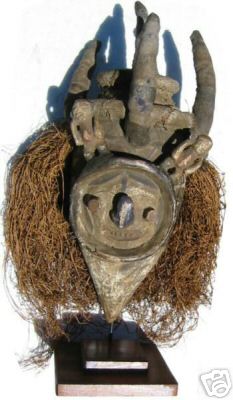
Illustration: Yaka circumcision initiation mask. Kwango river area, Democratic Republic of the Congo
Though human anatomy has been the object of scientific study since the 16th century, surprisingly little is known today about the structure and function of the foreskin. Perhaps the subject could not have been broached without venturing into forbidden territory; the foreskin does, after all, lie at the heart of the sacrificial ritual of circumcision.

Illustration: Yaka circumcision initiation mask. Kwango river area, Democratic Republic of the Congo
Almost certainly the foreskin has played some role in the propagation of the human species. At least we may assume the foreskin would not have persisted over millions of years if all it did was attract dust, thorn pricks and other natural hazards. In fact, the foreskin did not merely survive; it flourished to become the dominant and most visible feature of a mans reproductive equipment.
Before discussing the structure of the foreskin, we should note two basic principles of anatomy. First, structure and function are closely related. If we know what a structure looks like, we can make a reasonable guess at its function. If the foreskin looks like it is specialized for a particular function, then it probably is.
Second, no single part of any organ is a self-contained unit. For instance, a description of the fingers
at the end of an elephants trunk would mean very little without mention of the rest of the trunk. Similarly, the foreskin can only be understood as one part of the whole penis.
Another important point to note is that more than any other part of the body, the genitals have to suit two individuals. The penis must meet the needs of both user and usee!
The foreskin, which makes up about half the skin of the penis, is built like the lips, double-layered with skin outside and mucous membrane (mucosa
) inside. Despite their delicate appearance, the inner surfaces of the lips and foreskin are built to withstand frictional trauma; hence they are called frictional mucosa.
They are also waterproof to withstand damp conditions.
If for any reason they dry out, become infected (e.g. viral cold sores
) or physically abused (e.g. by premature retraction of the foreskin), they may develop slow-healing sores and cracks. If left unchecked, the end result may be scarring and contraction of tissues. Note: the inner lining of the foreskin has no source of protective secretion, such as sweat or sebaceous glands. The foreskin is damp because moisture escapes through its inner surface. As we have seen, this moisture keeps the foreskin in good shape, like well-waxed leather.
The foreskin, penile shaft, and scrotum share a very important—and unique—feature: a thin sheet of muscle fibres embedded right in the skin. This muscle layer, called Dartos muscle,
is best known for causing the scrotum to shrink during erection and of course during cold showers. As explained in Function, Dartos muscle also has an interesting and probably important effect on the skin of the penis.
The ridged band is a zone of strongly ridged or corrugated tissue normally hidden from view just inside the tip of the foreskin. Large bunches of coiled nerve endings known as Meissner
s corpuscles (also called genital corpuscles
) are concentrated in the peaks of the ridges. The ridged band was first described in 1996. (See British Journal of Urology, 1996, Vol. 77, pp. 291-295). There is no other structure like it on the human body.
The whole of the inner lining of the foreskin, the glans and the urethral opening form a muco-cutaneous junctional zone.
This means that (like the lips again) they lie at the junction between ordinary skin and mucous membrane. Muco-cutaneous junctional zones are rich in specialized nerve endings.
Females also have a muco-cutaneous junctional zone, but it is spread out over a wider area to form the inner labia and hood of the clitoris. It requires no great stretch of the imagination to realize that the ultimate purpose of penile erection is to bring one muco-cutaneous zone into contact with another.
The anatomy of the foreskin is discussed in more detail in a series of pictures.
The foreskin is specialized sensory tissue. Its unique structure, and the position of the ridged band, indicate sexual function(s).
The Circumcision Information and Resource Pages are a not-for-profit educational resource and library. IntactiWiki hosts this website but is not responsible for the content of this site. CIRP makes documents available without charge, for informational purposes only. The contents of this site are not intended to replace the professional medical or legal advice of a licensed practitioner.
© CIRP.org 1996-2026 | Filetree | Please visit our sponsor and host:
IntactiWiki.